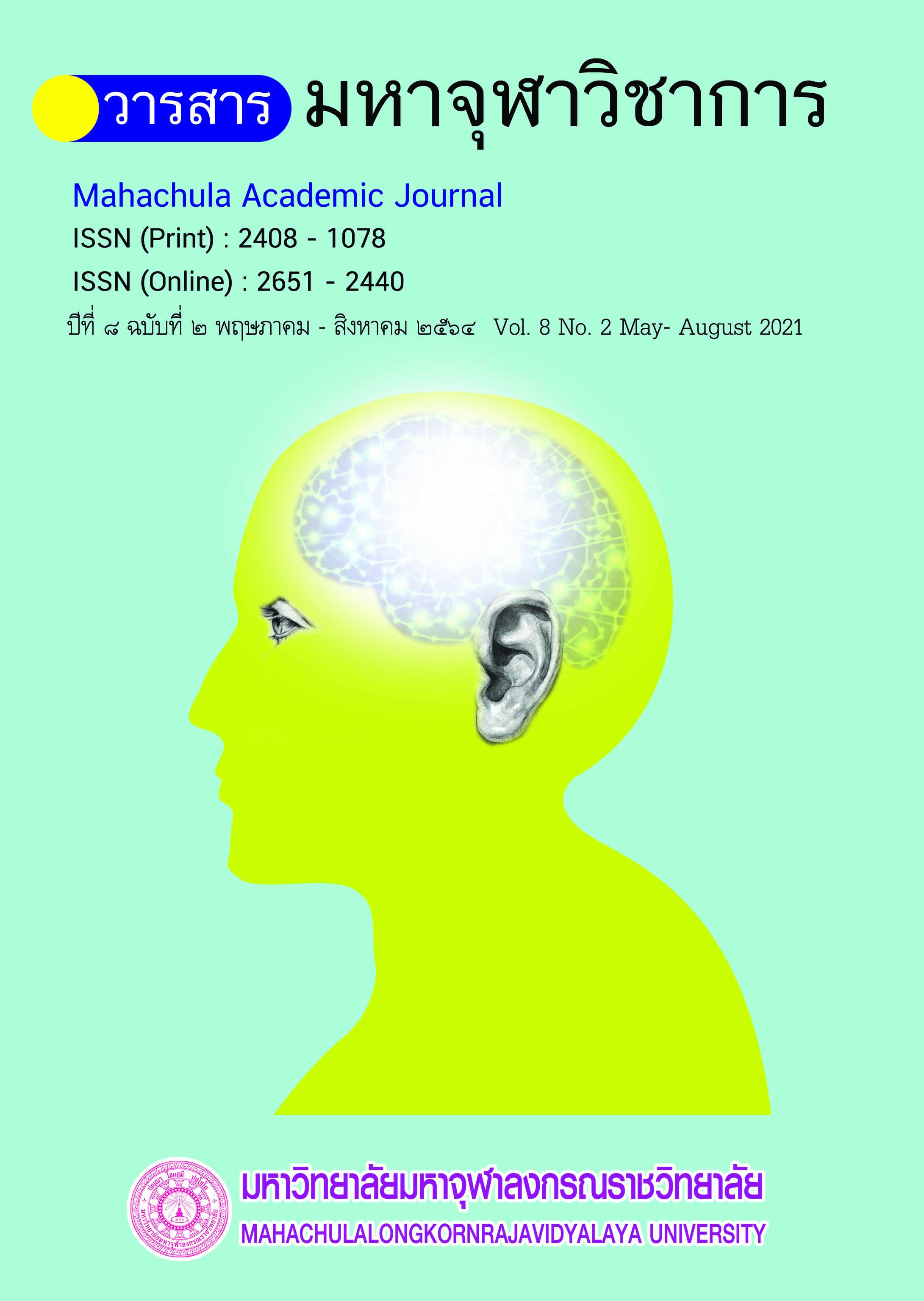A Guidelines for Developing the Cyber Security on Wireless Security at the Buddhist Places According to Hotel Guidelines
Main Article Content
Abstract
This research article objectives are (1) to study the guidelines for wireless security from the NIS standard;(2) to study the patterns of attacks via wireless network systems and prevention methods; (3) to study and find guidelines for the development of security in wireless networks in the area of the Buddhasthan.
Apply pattern qualitative research the population and samples are Atelecommu-nication specialist working in a computer network company and who have experience in computer networking by being a network installer The instrument used was a question-naire by interviewing 8 experts, divided into 2 groups.
The results of the study found that (1) wireless security guidelines from the National Institute of Standards and Technology (NIST) should proceed as follows: (1.1) Assigning rights such as OTP, MFA (1.2) Equipment that should be installed are: WIDS IDS/IPS and SIEM with UEBA function (1.3) Vulnerability check and patch update (1.4) Surveillance system (2) to study the patterns of attacks via wireless network systems and methods of prevention It covers all 8 areas as follows: (2.1) Confidentiality (2.2) Integrity (2.3) Availability (2.4) Access Control (2.5) Guidelines for preventing attacks via wireless networks by installing a WIDS system. The installation of APs must try to eliminate the signal from outside the area to a minimum. Added installation of user identification system and disable visibility between clients, etc. (2.6) Continuously monitor attacks and exploits through vulnerabilities. This may be used to help check or look at the reports in the IDS IPS (2.7) Guidelines for penetration testing and detection of security vulnerabilities are widely known. Check for device malfunctions Check nearby wireless devices. Check the internal access point. internal device test network fundamentals (2.8) Regular monitoring of attacks and exploitation and periodic assessment by making reports in days, weeks and months to analyze whether there are adequate preventive measures (3) guidelines for the development of security in wireless networks in the area of the Buddhasthan for consideration is for security in wireless network installations Firewall and WLAN should be zoned to separate the network into sections. including assigning access rights according to functions and receiving services in the following zones (3.1) A cubicle or room in a Buddhasthan area (3.2) a common area in a Buddhasthan area (3.3) a meeting room (3.4) an office (3.5) CCTV (3.6) A IOT device.
Article Details
References
ประชา เทศพานิช. “แนวทางการพัฒนาจริยธรรมของผู้ประกอบกิจการโทรทัศน์ดาวเทียมใน ประเทศไทยเชิงพุทธบูรณาการ”. วารสารบัณฑิตศึกษาปริทรรศน์. ปีที่ ๑๖ ฉบับที่ ๒ (พฤษภาคม -สิงหาคม ๒๕๖๓) : ๑๔๐.
พระมหาเอก เมธิกญาโณ เจตสลัน. “พฤติกรรมการใช้สื่อสังคมออนไลน์ ของพระนิสิตระดับปริญญาตรี มหาวิทยาลัยมหาจุฬาลงกรณราชวิทยาลัย อำเภอวังน้อย จังหวัดพระนครศรีอยุธยา”. วารสารมหาจุฬาวิชาการ. ปีที่ ๗ ฉบับที่ ๒ (พฤษภาคม-สิงหาคม ๒๕๖๓) : ๑๗๙-๑๙๐.
Anastasia Atavina V., Zareshin Sergei V., Rumyantseva Irina S., Ivanenko Vitaliy G. “Analysis of Security of Public Access to Wi–Fi Networks on Moscow Streets”. Russian: IEEE Conference of Russian Young Researchers in Electrical and Electronic Engineering (EIConRus). (2017). 105-110.
Benqdara Salima, Mahmoud Abdelfattah. “Wireless Security in Libya: A Survey Paper”. International Journal of Computer Applications. Vol. 181 No. 35 (2019) : 26-31.
Frankel Sheila, Eydt Bernard, Les Owens, Scarfone Karen. Establishing Wireless Robust Security Networks: A Guide to IEEE 802.11i. Special Publication 800-97. National Institute of Standards and Technology (NIST). 2007.
Homeland Security. A Guide to Securing Networks for Wi-Fi (IEEE 802.11 Family). Department of Homeland Security Cybersecurity Engineering. Version 1.0, (2017) : 4-5.
Murugiah Souppaya, Karen Scarfone. Guidelines for Securing Wireless Local Area Networks (WLANs). Special Publication 800-153. National Institute of Standards and Technology (NIST). (February 2012) : 1-12.
Mohmmed Somya Khidir, Al Mostafa Ahmed Hassan. “A review of threats, protocols, and solutions to enhance the security of wireless networks”. IJCSNS International Journal of Computer Science and Network Security. Vol.19 No.4 (2019) : 108-115.
วิโรจน์ จ้อยประเสริฐ. ๕ ข้อหลัก Zero Trust ต้องไม่เชื่อและตรวจสอบก่อนเสมอ. [ออนไลน์]. แหล่งที่มา: https://www.catcyfence.com/it-security/article/5-element-of-zero-trust. [๑๒ พฤษภาคม ๒๕๖๓].
ศุภเดช สุทธิพงศ์คณาสัย. Rogue AP..Access Point จำแลงแปลงกายมาดักข้อมูล. [ออนไลน์]. แหล่งที่มา: https://www.catcyfence.com/it-security/article/rogue-access-point/ [๒๔ มกราคม ๒๕๖๐].
Mareco Danny. 6 Ways Hotel Wi-Fi Is About More than Providing In-Room Guest Access. [Online]. Available: https://www.securedgenetworks.com/blog/hotel-wifi-is-about-more-than-in-room-guest-access. [23 March 2018].
Optimus Thailand. ทำความรู้จัก Multi-factor Authentication หรือ AuthPoint Mobile App. [ออนไลน์]. แหล่งที่มา: https://optimus.co.th/multi-factor-authentication-authpoint-mobile-app, [16 July 2020].
Singh Rajeev and Parval Sharma Teek. Security in Wireless Local Area Networks (WLANs). [Online]. Available: https://www.intechopen.com/books/computer-and-network-security/security-in-wireless-local-area-networks-wlans- [2019].


